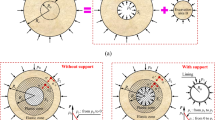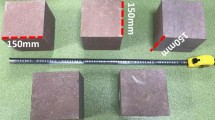Abstract
The elastoplastic analysis of a borehole was conducted using the elasto-brittle-plastic softening model and the Mohr-Coulomb strength theory, combined with earth pressure formulas derived from the cavity wall formula and Berezantsev’s formula. The analytical solutions for the plastic zone radius and radial displacement are presented. Using the curves of the plastic zone radius and the wall displacement of the borehole versus borehole depth, the influence of various factors such as different earth pressure calculation methods, the unloading process, the borehole radius, and the dilatation and softening effects are discussed in detail. According to the results, the use of the cavity wall formula leads to convergence easily and both the knee points for the plastic zone radius and the wall displacement of the borehole occur in the shallower part of the borehole. On the other hand, according to Berezantsev’s formula, the earth pressure increases along the shaft, following a hyperbolic curve, and continues to increase at the bottom of the borehole. Because there is a significant difference between the results of the previous two methods, an integrated method for estimating the earth pressure should be derived using the in situ results. The unloading process, borehole radius used in the design, dilatation and softening effects, etc., also have a great influence on the plastic zone radius and the wall displacement of the borehole. Moreover, the borehole radius has huge impact on the boundary force.
Similar content being viewed by others
References
Ahmadabadi, M. and Ghanbari, A. (2009). “New procedure for active earth pressure calculation in retaining walls with reinforced cohesivefrictional backfill.” Geotextiles and Geomembranes, Vol. 27, No. 6, pp. 456–463.
Benmebarek, K. T., Benmebarek, N., and Kastner, R. (2008). “Numerical evaluation of 3D passive earth pressure coefficients for retaining wall subjected to translation.” Computers and Geotechnics, Vol. 35, No. 1, pp. 47–60.
Carsten, H., Bernhard, W., Philippe, M., and Barnardo, C. (2008). “Application of inverse FEM to earth pressure estimation.” Finite Elements in Analysis and Design, Vol. 44 No. 11, pp. 705–714.
Chen, Z.-J. and Liu, Y.-J. (2008). “Model experimental research on compacting efect of concreting for overlength and large-diameter bored pile.” Rock and Soil Mechanics, Vol. 29, No. 12, pp. 3277–3281.
Cheng, Y. M. and Hu, Y. Y. (2005). “Active earth pressure on circular shaft lining obtained by simplified slip line solution with general tangential stress coefficient.” Chinese J. Geotech. Eng., Vol. 27, No. 1, pp. 110–115.
Cheng, Y. M., Hu, Y. Y., and Wei, W. B. (2007). “General axisymmetric active earth pressure by method of characteristics-theory and numerical formulation.” International Journal of Geomechanics, Vol. 7, No. 1, pp. 1–15.
Chun, B. and Shin, Y. (2006). “Active earth pressure acting on the cylindrical retaining wall of a shaft.” South Korea Ground Environ. Eng. J., Vol. 7, No. 4, pp. 15–24.
Hu, X.-M. and Li, Z.-D. (2007). “Hole forming mechanics analysis of the bored filling pile on the bridges in alluviation overburden area.” Journal of Wuhan University of Technology (Transportation Science & Engineering), Vol. 31, No. 4, pp. 734–737.
Jiang, M. and Shen, Z. (1995). “On expansion of cylindri-cal cavity with material softening characteristic.” Chinese Journal of Geotechnical Engineering, Vol. 17, No. 4, pp. 10–19.
Jiang, M. and Shen, Z. (1996). “On expansion of cylidrical cavity with elast-brittle softening and shear dilatation bahaviour.” Journal of Hoihai University, Vol. 24, No. 4, pp. 65–72.
Liu, F. Q. and Wang, J. H. (2008). “A generalized slip line solution to the active earth pressure on circular retaining walls.” Computers and Geotechnics, Vol. 35, No. 2, pp. 155–164.
Liu, F. Q., Wang, J. H., and Zhang, L. L. (2009). “Axi-symmetric active earth pressure obtained by the slip line method with a general tangential stress coefficient.” Computers and Geotechnics, Vol. 36, Nos. 1–2, pp. 352–358.
Luciano, T., Annamaria, C., and Giancarlo, G. (2010). “A numerical interpretation of load tests on bored piles.” Computers and Geotechnics, Vol. 37, No. 3, pp. 425–430.
Ma, Y. (1979). “Theory and practice of ground pressure on shaft due to thick overburden.” Journal of China University of Mining & Technology, Vol. 1, No. 1, pp. 45–69.
Tatiana, T. and Mohamed, A. M. (2010). “Comparative evaluation of methods to determine the earth pressure distribution on cylindrical shafts: A review.” Tunnelling and Underground Space Technology, Vol. 25, pp. 188–197.
Toshihisa, A., Makoto, K., and Kiyoshi, K. (2003). “Experimental study on the distribution of earth pressure and surface settlement through three-dimensional trapdoor tests.” Tunnelling and Underground Space Technology, Vol. 18, Nos. 2–3, pp. 171–183.
Wen, S., Chen, Y., and Li, X. (2002). “Analytical solutions for contracting cavities with consideration of strain softening.” Chinese Journal of Rock Mechanics and Engineering, Vol. 21,Supp. 2, pp. 2432–2438.
Xin, G. (2006). Test and theory study on shafat resistance softening of large diameter and super-long piles, Zhejiang University, Hangzhou.
Yu, H. S. and Rowe, R. K. (1999). “Plasticity solutions for soil behaviour around contracting cavities and tunnels.” International Journal for Numerical and Analytical Methods in Geomechanics, Vol. 23, No. 12, pp. 1245–1279.
Zhao, J. and Wang, G. (2010). “Unloading and reverse yielding of a finite cavity in a boundedcohesive-frictional medium.” Computers and Geotechnics, Vol. 37, Nos. 1–2, pp. 239–245.
Author information
Authors and Affiliations
Corresponding author
Rights and permissions
About this article
Cite this article
Zhao, C., Yang, Y., Zhao, C. et al. Analytical solution for borehole contraction caused by radial unloading. KSCE J Civ Eng 17, 60–67 (2013). https://doi.org/10.1007/s12205-013-1209-9
Received:
Revised:
Accepted:
Published:
Issue Date:
DOI: https://doi.org/10.1007/s12205-013-1209-9




